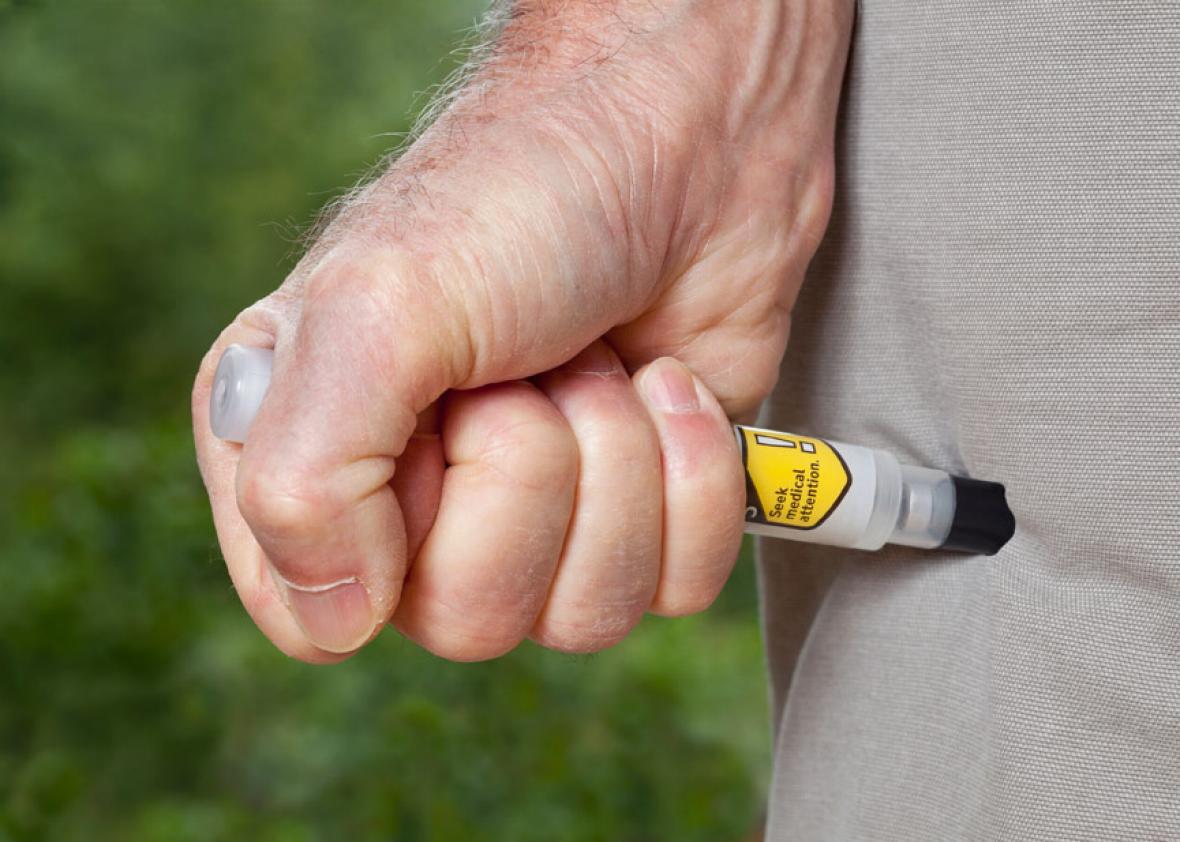If you’re one of the 3.6 million people with an EpiPen prescription, you probably paid way too much for it—if you could afford it at all. That’s because, since buying the rights to the device nine years ago, the pharmaceutical company Mylan has pushed a relentless series of price hikes that has seen the cost of the device go from an average of about $50 in 2004 to more than $300 each today.
EpiPen is by far the most common brand of devices known as epinephrine autoinjectors, which are premeasured, automatic syringes that contain epinephrine (also known as adrenaline), which helps keep airways open during severe allergic reactions. For many people—including children—it is a potentially life-saving treatment. Thus, the price-gouging can be downright dangerous: A story out Wednesday from Stat details how, in an effort to combat the expense of EpiPens, some users and institutions have started replacing the devices with regular syringes filled with vials of epinephrine. While the effect is the same in theory, this cheaper method introduces a much wider margin of error for administering the medicine correctly, all to cut costs.
So why is the EpiPen so expensive? In September, reporting by Bloomberg Businessweek blew open the story about Mylan’s quest to make the EpiPen a cash cow; the device alone now makes up a full 40 percent of Mylan’s profits, thanks to a series of strategic marketing campaigns, public policy changes, and price hikes. For one thing, in 2010, the company decided to sell EpiPens in twin packs and discontinued single EpiPens. Between 2011 and 2014, television advertising skyrocketed from $4.8 million to $35.2 million. In 2013, Congress encouraged schools to carry EpiPens after a 7-year-old in Virginia died of an allergic reaction to peanuts. Following that encouragement, Mylan also contracted with Walt Disney to provide the device at its theme parks and cruise ships (at a cost, of course).
The price of the device has been steadily increased—by 32 percent in the past year alone—but not because the cost of the raw materials was increasing (a typical dose of epinephrine still costs about a dollar). The profit margin of the EpiPen was 9 percent in 2008. Today it’s 55 percent. The company claims it’s improved the technology but can’t specify exactly how.
Of course, all of this is basic capitalism, and it seems the EpiPen is simply lacking competition, thus creating the runaway price increase. The last serious competitor to the EpiPen, Auvi-Q, was discontinued in October of last year following claims that the device was inconsistent in the dosages it administered. Another similar device, Adrenaclick, was prescribed less than 1,000 times in the U.S. last year, because of concerns that it wasn’t as easy to use. (Its generic was prescribed 183,000 times, a small number when compared with the number of EpiPen prescriptions.*) And a prescription for an EpiPen cannot be filled with Auvi-Q or Adrenaclick, since the two alternatives are not similar enough, according to the Food and Drug Administration. In fact, no generic version of the EpiPen is currently available, and the FDA recently blocked a request by the pharmaceutical company Teva to start producing one.
Stat’s story debates whether using the syringe method is actually as safe as using an EpiPen. Unsurprisingly, there are risks to injecting adrenaline into the body with little practice or knowledge—epinephrine that’s accidentally injected into a vein instead of the muscle can be lethal—though different stakeholders disagree on how serious or common said risks are and how much injecting with a syringe increases them. Several local governments are now training their emergency medical responders to use the syringe method to save on the costs of stocking up on EpiPens, and some parents are going that route as well. Others have decided to hold on to their expired devices, even though research has shown that EpiPens with epinephrine more than a year old show a marked decrease in efficacy.
The Stat story ends somewhat pessimistically, positing that perhaps the syringe method is simply an alternative we have to accept. “Everyone wants to drive around in a Cadillac, but not everybody does,” Richard Lockey, a professor at the University of South Florida, told Stat.
We don’t have to accept the junked-car equivalent of this medicine, though. Although the FDA can’t set a fixed price for drugs and medical devices like regulators in other countries can, the outrageously ballooning cost of the EpiPen should be enough to spur the creation of a generic alternative. Perhaps this move—or even the possibility of such competition—could scare Mylan into scaling back its decadelong price gouge.
We know a cheaper EpiPen is possible—it’s just not as profitable.
Update, July 8, 2016: The original photo on this post showed an older version of the EpiPen being injected into the user’s arm. The current EpiPen instructions say to inject it into the thigh. The photo has been switched out.
Update, July 15, 2016: This article has been revised to note that the generic of Adrenaclick was prescribed 183,000 times.
